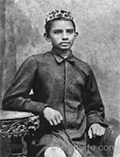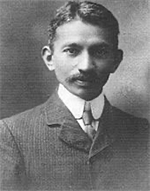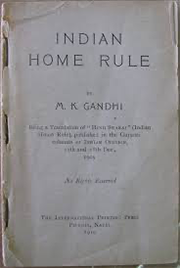Mohandas Gandhi: Independent India's Guiding Light
Part 1: From Trade to Governance Mohandas Gandhi was perhaps the most famous people ever born in India. A shy, retiring figure for much of his early life, he became a strong, inspiring presence and led his country's resistance against and then independence from British rule. 
He was born on Oct. 2, 1869, the sixth child of his father and the third child of his mother, who was his father's fourth wife. His family lived in Porbandar. His father, Karamchan, served as chief minister of Porbandar state. Gandhi took after Putlibai, his mother, a deeply pious woman who would offer up prayers at every meal and several other times during the day. He was an average student, shy and tongue-tied. He preferred reading books to playing with other kids. He was married at 13 to a 14-year-old Kasturba Kapadia; it was an arranged marriage. He affectionately called her "Ba." They had four children of their own. 
Gandhi came from a poor family, and his wife's family didn't have much, either. The custom at the time was for new brides to still live with their families, especially when they were still teenagers. Gandhi decided that he wanted to study law in London. His wife's family was not happy with the decision, so Gandhi made a vow to abstain from meat, alcohol, and women while he was away studying law. He was 18 in 1888 when he went to London. Three years later, he graduated from law school and found admittance to the bar. By that time, he had overcome his tongue-tied nature and could give public addresses, as a lawyer would in a trial. But he found that he was psychologically unable to cross-examine opposition witnesses, which was a vital skill for a trial lawyer to have. Gandhi had a distant cousin in South Africa who needed a lawyer, so Gandhi went there. It was 1893; he was 23. In South Africa, he faced discrimination because of his skin color. On the way there, he had to sit on the floor of a stagecoach. In South Africa at that time, Indians could not walk on public sidewalks; a policeman kicked Gandhi off the sidewalk and into the street. Gandhi had grown up under the British Raj and thought of himself as a Briton first, but these experiences made him re-examine this philosophy, especially after hearing of many such incidents from his fellow Indians living in South Africa. He served in the Boer War, as a stretcher-bearer for the Ambulance Corps. It was there that he showed glimpses of being able to rally large groups of people. He convinced 1100 other Indians living in South Africa to join him in the British war effort. In 1906, after a fresh round of discrimination in South Africa, Gandhi first decided to follow the Satyagraha, a Hindi word that meant, in English, "holding onto truth." In essence, this was the beginning of his campaign of nonviolent resistance to violence. Also in this year, Britain declared war against the Zulu Kingdom, and Gandhi sided with the Zulus, urging his fellow Indians to do the same. In 1908, a magazine editor named Tarakuatta Das wrote a public letter to Tolstoy, asking him to express his opinion on the situation in India. Tolstoy, a noted proponent of nonviolence, gave his answer in the form of the famous Letter to a Hindu. Gandhi, in South Africa at the time, was so taken with Tolstoy's response that he wrote him a letter, and the two wrote letters back and forth for a year. Gandhi sent Tolstoy a copy of his book Indian Home Rule. Gandhi had finally had enough of South Africa and in 1915 returned to India. He quickly joined the INC and became its leader in 1920. 
The year before, British officers had opened fire on a large group of unarmed people peacefully protesting; a riot ensued, and Gandhi was arrested – not for the first time. Gandhi urged a nonviolent response to the violence and, not for the last time, went on a fast-to-the-death. Gandhi, who was known as Mahatma, also embraced the doctrine of swadeshi, the idea of buying locally made goods; swaraj, the idea of self-rule, meaning Indians ruling Indians; and the wearing of the khadi, or humble cloth. On Jan. 26, 1930: Gandhi and the INC declared India independent from the U.K. The U.K. didn't agree to this change, and India was still part of the U.K.; but it was significant that this very public group had made this very public pronouncement, of its desire to leave the British Empire. One other bone of contention with the local population was that as far back as 1876, the ruling monarch had been styled Emperor of India. The first to do so was Queen Victoria, who was Empress of India. But her successors all took the title of Emperor of India. Indians still had stories about how previous generations had struggled under the rule of the Mughal emperors. Even though the U.K. emperors and empress were more benevolent by comparison, the idea of having an imperial head of state was still objectionable to many Indians. Next page > A Life's Work > Page 1, 2
|
|
Social Studies for Kids
copyright 2002–2025
David White




